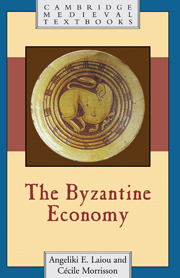Book contents
- Frontmatter
- Contents
- List of maps
- List of figures
- List of tables
- Acknowledgements
- List of abbreviations
- Introduction
- I Natural and human resources
- II The Late Antique economy and the shift to medieval structures (sixth–early eighth centuries)
- III Restructuring, recovery and controlled expansion (early eighth to tenth centuries)
- IV The age of accelerated growth (eleventh and twelfth centuries)
- V Small-state economics (from sometime in the thirteenth century to the fifteenth century)
- VI The Byzantine economy as exemplar; the Byzantine and the Western medieval economies
- Select bibliography
- Index
- Cambridge Medieval Textbooks
I - Natural and human resources
Published online by Cambridge University Press: 05 June 2012
- Frontmatter
- Contents
- List of maps
- List of figures
- List of tables
- Acknowledgements
- List of abbreviations
- Introduction
- I Natural and human resources
- II The Late Antique economy and the shift to medieval structures (sixth–early eighth centuries)
- III Restructuring, recovery and controlled expansion (early eighth to tenth centuries)
- IV The age of accelerated growth (eleventh and twelfth centuries)
- V Small-state economics (from sometime in the thirteenth century to the fifteenth century)
- VI The Byzantine economy as exemplar; the Byzantine and the Western medieval economies
- Select bibliography
- Index
- Cambridge Medieval Textbooks
Summary
LAND AND ENVIRONMENT: GEOGRAPHY, CLIMATE, NATURAL RESOURCES AND THEIR USE
The geographic area considered in this book is centered on the Mediterranean. This was not affected by the territorial changes that occurred as part of the transformation of the Late Roman Empire in the fourth century (c.3.7 million km2) into the more restricted medieval entity which we call the “Byzantine” Empire: the fall of the Pars Occidentalis meant a decrease to a total area of c.1.3 million km2. The reconquest of western provinces entailed only a partial and temporary recovery to c.2.7 millions km2 under Justinian. After the Arab conquests and the long struggles of the Middle Byzantine period, the Empire consisted of only c.1.2 million km2 at its height in the reign of Basil II, and c.750 000 km2 in the mid-twelfth century. The fact that this territory was always centered on the Mediterranean and on the Black Sea does not imply that it enjoyed an exclusively Mediterranean or maritime climate. The Mediterranean climate with its dry and hot summers (c.28° on average) and mild winters (c.8° average in January) with irregular and varying rainfall, obtains only in the coastal regions on either side of the Aegean or the Ionian and Adriatic seas. Its area can be plotted against the isotherm of an average 3° in January which is the limit of olive culture.
- Type
- Chapter
- Information
- The Byzantine Economy , pp. 8 - 22Publisher: Cambridge University PressPrint publication year: 2007



